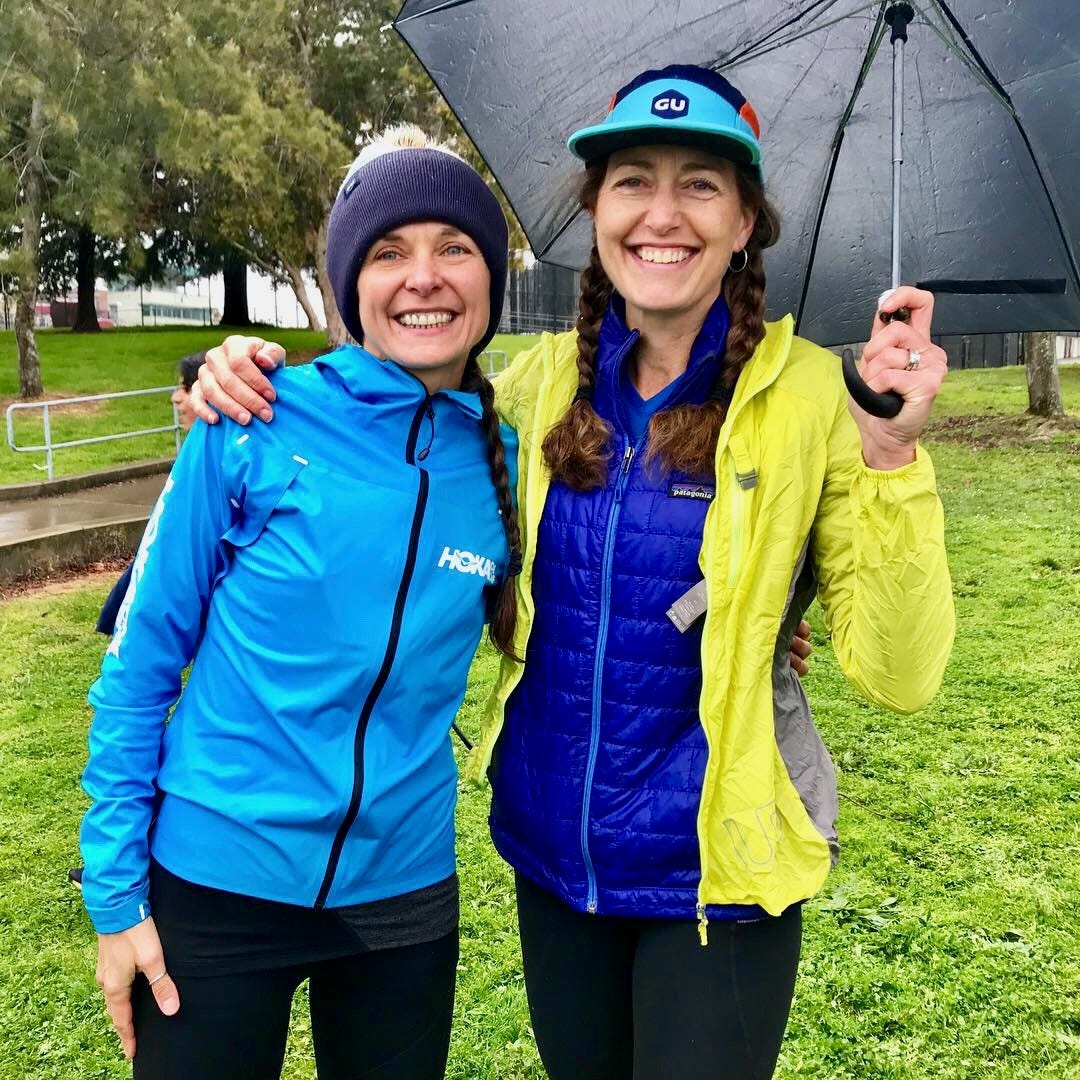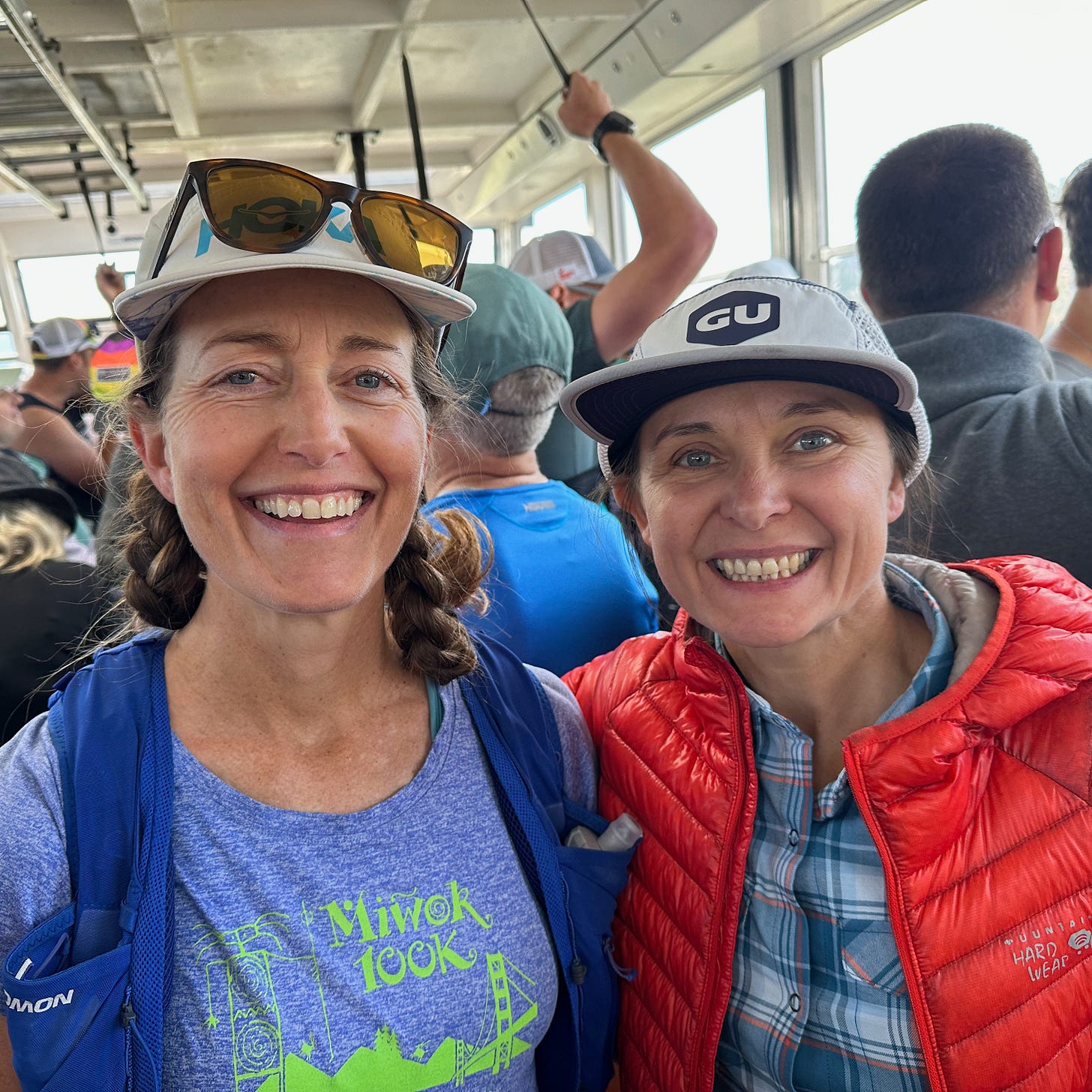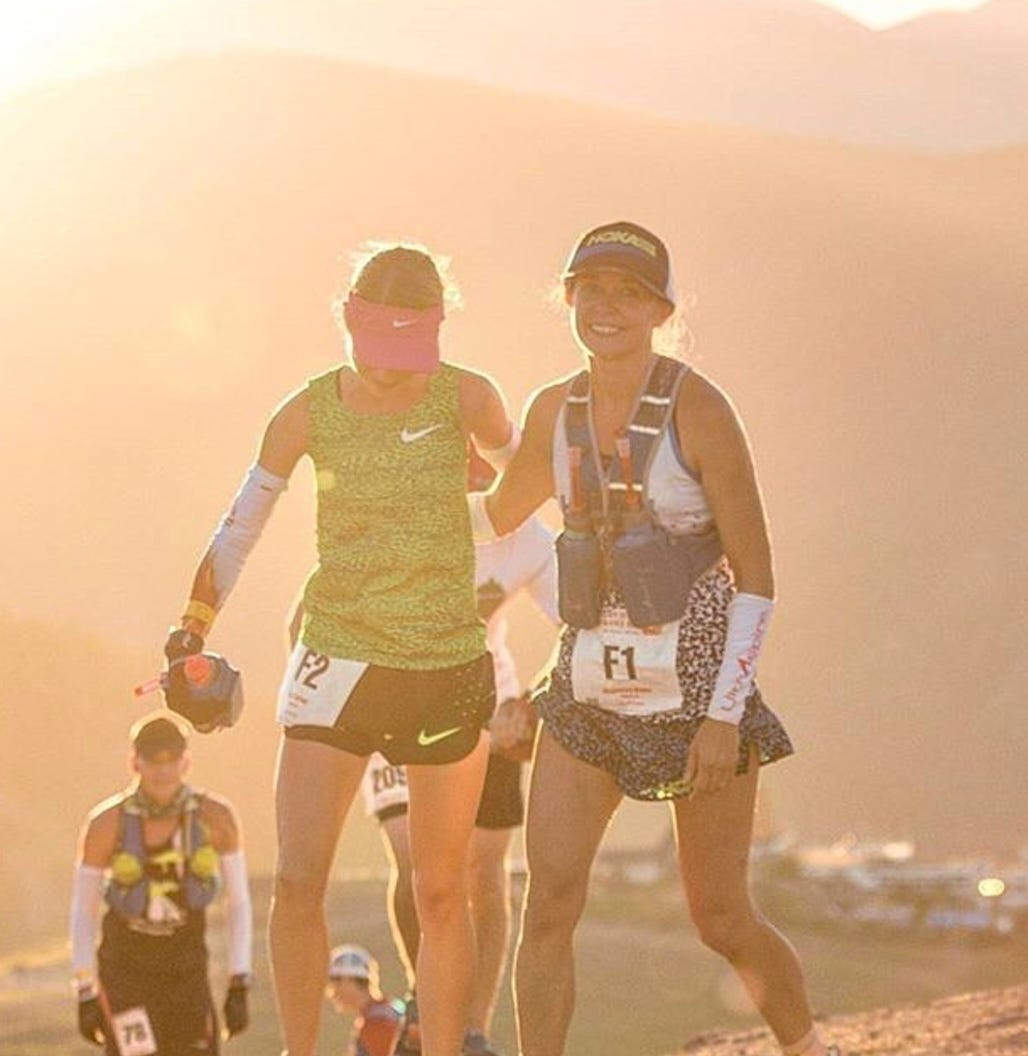Magda's Return to Running
The former Olympic marathoner and Ultrarunner of the Year talks about turning 50 and getting a hip replacement
Last week’s post centered on the Oakland/Berkeley hills of the East Bay Area. While there, I thought about an Oakland runner whom I’ve long followed and had the good fortune to get to know over the years: Magda Boulet, a former Olympic marathoner and the 2015 Western States Endurance Run (WSER) 100-mile champion and UltraRunning magazine’s Ultrarunner of the Year. I wished she would appear around one of the redwoods so we could cross paths and chat, as we sometimes did when I lived and ran there.
Coincidentally, as I was traveling back from Oakland to Colorado, I listened to Andy Jones-Wilkins’ recent podcast interviewing Magda, who’s now 51. Oh good, I thought, I’ve been wondering how she’s feeling and running since she turned 50 and had a full hip replacement. But AJW’s interview focused almost entirely on recounting her runs at Western States and talking about the event, since Magda is a WSER board member.
Wanting to hear more about Magda herself—in particular her relationship with running in our 50-plus age bracket and her brand-new hip—I decided to get in touch with her for a Q&A. She was happy to oblige, and we Zoomed while she sat at GU’s Berkeley headquarters, where she serves as the company’s president.
I’m delighted to bring this interview with Magda to you, and to introduce her to a younger generation of runners who may not know her story. She continues to inspire me. She’s someone for whom nothing came easily, and yet she rose to the top athletically and professionally. She continues to evolve and is poised for a comeback. She fills me with optimism both about running after 50 and also about our sport itself.

First, some background for context.
Becoming a runner, an American, and an Olympian
Magda, which is short for Magdalena, grew up in communist Poland and lived there until she was 15. As a kid, she was an avid swimmer on a swim team. Her father moved to Germany for a couple of years to work, and then Magda and her mother and brother were able to follow him there. Eventually, the family immigrated to Long Beach in Southern California. As a high school student new to America and struggling to learn English, she made a few friends who were on the cross-country team, so she took up running to be with them. She also worked part time at a Taco Bell to help support her family financially.
At her first college, Long Beach City College, she fell in love with running on the track and cross-country teams. Gaining a scholarship for a better education became an added incentive for her to succeed in the sport. She gained attention at a state meet by competing and podiuming in the triple—the 1500, 3000, and 5000-meter events (few runners do all three at the same meet)—and then had the gumption to contact the coach at UC Berkeley and tell him she wanted to run for Cal. The coach took a chance and met her, then invited her onto the team, and she transferred to Berkeley to run and study biology for the next three years. It was there where she met her future husband, Richie Boulet, who ran on Cal’s men’s team.
Fast forward a few years to 1999, when she was trying to take her 5K performance to the next level. She visited the relatively new company, GU Energy Labs, for nutrition advice. She got a job there working as a research assistant and, over the next two decades, worked her way up to lead the company.
In 2001, she completed the process to become a U.S. citizen and went to San Francisco’s federal building for the swearing-in ceremony. The morning just happened to be September 11, with chaos unfolding in New York and fears that terrorists would attack the West Coast. The ceremony went forward, rushed under the circumstances, and Magda now recalls the 9/11 anniversary both with sadness and gratitude for her citizenship.
In the early 2000s, she graduated to the marathon distance and tried but missed getting a spot on the 2004 Olympic team. She and Richie, now married, had their one child in 2005, and after postpartum recovery, Magda rededicated herself to long-distance running with an eye on the 2008 Olympics Marathon in Beijing. To qualify, she trained with coach Jack Daniels (the legendary coach who wrote Daniels’ Running Formula) and prepared for the Olympic Trials in Boston that April, the day before the Boston Marathon.
She stuck to her plan to run a 5:45 pace for a 2:30 finish and found herself out in front, an unknown. With only 2.5 miles left, Deena Kastor caught and passed her for the win, but Magda finished 2nd only 44 seconds behind, in 2:30:19—a big PR for her, at age 34. (She later lowered her marathon PR to 2:26:22 in 2010.)
Draped in an American flag and having earned a spot on the Olympic team, she told the New York Times while teary at the finish line: “This is a dream come true. … Coming from a different country and having the opportunity to do whatever I wanted to do is pretty amazing. I just tried to grab the opportunities, and this is one of them.”
Sadly, the 2008 Olympic Marathon in Beijing did not go her way. I was at a gathering at our favorite Oakland running store, TranSports, in December of 2008 when she described the heartbreaking turn of events in Beijing: She flew there on her 35th birthday, one week before the marathon, and got on a shuttle bus to the Olympic Village. The bus stopped, she stood to walk down the aisle, and whack! she accidentally rammed her knee into an armrest. She couldn’t believe what she had done, even as her knee began stiffening and swelling. “I was in huge denial,” she said about the week in Beijing, leading up to the marathon. She was limping around but “nothing was going to stop me from at least trying.” So she lined up with the other women and started the race, but her knee wouldn’t cooperate. She dropped around mile 12. “One little thing just took that all away,” she said of the shuttle bus accident.
Five years later, Magda launched a new phase of her running career—that of an ultrarunner. Her first ultra was the 2013 North Face Endurance Challenge 50-miler, which at the time was one of the most competitive American ultras, and she finished 2nd.
Before Courtney, there was Magda
In 2014 and 2015, Magda was on fire as the top female ultrarunner in the United States. In 2014, she won the Way Too Cool 50K and North Face Endurance Challenge 50M, then in 2015, the Sean O’Brien 100K, Canyons 100K, and Western States 100M—her first 100-miler—in spite of going off course for about two miles and having to fight her way back to the lead.

In the years that followed, she also was first female of the 2018 Marathon des Sables self-supported stage race, and the female champion of the 2019 Leadville 100.
When I asked Magda to share her favorite photo from her Western States races, it’s notable that rather than send one showing her solo and triumphant, she sent me this one from the 2017 Western States 100 (when she finished 2nd) with her close friend Kaci Lickteig. The two women had buddied up to run together at the Lake Sonoma 50 that season and crossed the finish together. Magda is happy to share the spotlight and support others.
As more faster women came onto the ultra scene, eclipsing Magda’s winning time at Western States, and as her hip caused chronic dull pain, she became less competitive. Her last ultra was the Western States 100 in 2021, where she placed 15th. Later that year, she underwent a full hip replacement, which we discuss below.
In addition to working full time as president of GU, where she oversees the executive team and some 60 employees, Magda also gained a seat on the WSER Board of Directors in 2020, and she co-directs the Miwok 100K (one of my favorite races).
What follows is our chat last Friday, condensed.
A comeback to racing?
Me: Remind me, Magda, when did you have your big surgery?
Magda: “It was November of 2022, around Thanksgiving. I had a full hip replacement on my left hip. My hip socket and the head of the femur were really tight, causing a lot of friction and eventually bone on bone, and running accelerated that condition. For a couple of years it was really uncomfortable to run on it and even live with it. Sleeping, sitting—it was dull pain, not excruciating, but just constant. I went through a couple of doctors and couldn’t get to a decision until I met Dr. John Diana, the medical doctor at Western States for a few years who specializes in hips. I finally met someone who truly lives and understands running—he’s an ultramarathoner—and has worked on hips, and that got me across the finish line to make the decision. He addressed my concerns and also painted a realistic picture for the future and what I could be doing with the sport that I love.”
How are you feeling now, a year and three months later?
“I feel like I got my second life. I feel great! I took a very conservative approach to my rehab; I wasn’t rushing it, I stayed very patient with everything that Dr. Diana prescribed. I wasn’t really in a hurry. In the past when I had an injury, I was always rushing to come back. This time I was coming back to something much bigger than any race, and it’s being able to have running in my life. That perspective allowed me to enjoy the process of recovery and be patient and really listen to my body. It took six to eight months before I actually had some confidence that I can run every day. And now that it’s been over a year, I’m a lot more confident to incorporate higher intensity into my training, a lot more technical running and trails. I’m running about five to six times a week, and my long run is anywhere from 12 to 20 miles depending on how I feel. If you asked me six months ago, I’d say I was very hesitant to race; my head space was not even ready to think or dream about racing, and now I’m like, ‘What do I want to do?’ so I’m in a good place with running.”
Magda running in early 2024, as seen on her Instagram post:
So, what are your goals now?
“My goal is to pick something. I don’t have anything on the calendar. I’d like to do a sub-ultra to begin with and see how that goes. I’m at the stage now where I crave structure [in training] versus just getting out the door, and having a training plan. But I’m not in a rush. Whether I sign up for a race in a month or six months, I’m OK with that. I’m looking at the next few decades and how I want to stay closely connected to the running community.”
Tell me about passing the milestone of age 50. Was that a big deal?
“Every decade has been fun; I always look forward to doing something different on my birthday. I have a positive relationship with every decade. When I turned 40, I wanted to run 40 miles for the first time in a day, and I wasn’t able to do that, so I did two 20s. This time around, it really hit me that I can’t run 50 miles, coming off a big surgery, and just taking that perspective and realizing that yes, I’m aging, I’m going through menopause, I have hot flashes all the time—it’s kind of a joke in my house, I say, ‘It’s happening right now!’ and trying to find some humor in the aging process. My attitude is, I’m just rolling with it and having fun, but also paying attention to the reality of it and focusing on strength training and all the little things, so much more than chasing mileage. When I had the surgery, I learned my bones are really strong, so that was a great takeaway and I’d like to maintain that, so I’m focusing on strength training and mobility in general.”
Tell me about your board service for WSER. What are some of the biggest challenges you and the board face?
“I’ve been closely involved with a lot of the policy work, because I serve on the DEI committee with Diana [Fitzpatrick, the WSER board president]. That was the first committee I joined, and I’m proud we have that committee. It’s where we pay attention to the policy around transgender or nonbinary runners, or pregnancy policy, or drug testing—all of that work is led by the committee, and I’m the chair of it, with Diana’s strong leadership, allowing me to play a big role. It’s not easy work because those policies have to be vetted and pressure-tested. Going back to our values and vision to be a leader in this sport, we need to be ahead of all this and be proactive rather than reactive. What I’m learning from Diana in this work is that bringing people along is really important and takes time. We continue to evolve our policies, to evolve with the sport, and that takes a lot of learning and making tough decisions. It’s complicated and complex, and sometimes there’s not a clear answer of what’s right or wrong because we don’t have all the answers from the science community. That being said, you still need to show up and stand for something and make a decision, and know there are consequences to these policies and there are human lives involved with it, and it’s serious work that takes a lot of emotional energy. At the same time, how lucky we are to be involved in this and take the sport to the next level.”
What overarching issue do you think is crucial to WSER’s future?
“With the uniqueness of the race—it’s a small race [with a permit allowing a maximum of 369 runners annually], so it will never have thousands of people being able to run Western States in any give year—it’s looking for ways to bring people in and not keep people out. That’s one topic we need to continue to stay on top of: How do we continue to be relevant and serve our communities and open doors for people to make it into Western States? Knowing the permit is the constant, there’s still a lot we can do in terms of breaking down barriers for people to come and be part of Western States, not just participants but also volunteers, and making people feel welcome when they come to watch.”
How are you feeling about the sport in general now, since it has grown and evolved so much in the past decade?
“I’m super excited. It’s inspiring and mind-blowing, the level of performance and level of output we’re seeing. I just have a huge appreciation for the next generation. I see it as building up what the prior generation created, and it’s so fun to see the sport evolve to what we maybe thought was impossible, and now the records are breaking and training is even more sophisticated. It makes me wonder and keeps me curious about what’s really possible. Even watching the Olympic trials, I was blown away by the performances. I have to learn names and follow the new stars, which is all fun. It keeps me on my toes. I’m at the point where I’m learning from them. It’s like science— science evolves, and it’s our job to stay current and on top of it. That’s how I see the new generation: They’re going to do things we never thought possible, and it’s fun to watch.”

Thank you, Magda, for talking to me and for your big dose of positivity!
More on Magda:
“How Magdalena Boulet Summited the World’s Highest Volcano”: A piece I wrote in 2018 for Trail Runner about Magda reaching a 22,615-foot summit as part of a grueling research project.
Billy Yang’s 2017 podcast interview with Magda: This interview is really well done and focuses on her immigrant experience.
If you’d like to support this newsletter but would rather not commit to a paid subscription, please consider making a small donation to my virtual tip jar, thank you.




Great to hear Magda is doing well, and is running strong after her hip replacement. I had no idea she was the President of Gu now. That’s awesome! I was fortunate enough to meet her at Leadville in 2019 at the Mount Elbert trailhead. She was very kind and generous with her time. Despite running Leadville herself, she was still working the expo booth the day before the race, giving out samples of Boon. I am, and will always be, immensely inspired by ultrarunners that have a career and a family and run at a high level. Sure it’s fun to see some of the best go all in and break records, but when someone is juggling family and work demands and still exploring the limits of the human body, that’s what helps me stay motivated to chase my own goals.
Thanks yet again for an awesome and inspirational post